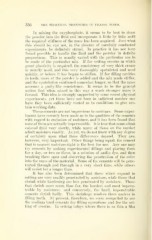Page 698 - My FlipBook
P. 698
356 THE TECHNICAL PBOCEDURES IN FILLING TEETH.
In mixing the oxypliospliate, it seems to be best to draw
the i^owder into the fluid and incorporate it little by little until
the required stiffness of the mass has been acquired. Just what
this should be, can not, in the absence of carefully conducted
experiments, be definitely stated. In practice it has not been
found possible to handle the fluid and the powder in definite
proportions. This is usually varied with the particular use to
be made of the particular mix. If for setting crowns in which
great plasticity is required, the consistency of very thick cream
is usually used, and this very thoroughly spatulated and used
quickly, or before it has begun to stiffen. If for filling cavities
in teeth, more of the powder is added and the mix made stiffer,
and the spatulation continued somewhat longer, so that the mass
assumes a putty-like consistence. It seems to be the general
notion that when mixed in this way a much stronger mass is
formed. This idea is strongly supported by some recent physical
experiments, yet these have not been in sufficient number nor
have they been sufficiently varied as to conditions to give cer-
tain working data.
These cements are not impervious to moisture. Some exper-
iments have recently been made as to the qualities of the cements
with regard to exclusion of moisture, and it has been found that
none of them are actually impermeable. It is true that some admit
colored fluid very slowly, while many of those on the market
admit moisture readily. As yet, we do not know with any degree
of certainty upon what these differences depend. They are,
however, very important. Other things being equal, the cement
that is nearest moisture-tight is the best for use. Any one may
try cements by making experimental fillings and placing them
for a day, or two or three, in a solution of anil in dye, and then
breaking them open and observing the penetration of the color
into the mass of the material. Some of the cements will be pene-
trated through and through in a very short time, while others
will resist for a longer time.
It has also been determined that those which expand in
setting are very readily penetrated by moisture, while those that
shrink while hardening are less penetrated by moisture. Those
that shrink most seem, thus far, the hardest and most impene-
trable by moisture; and conversely, the hard, impenetrable
cements shrink badly. This shrinkage renders them useless in
filling teeth. At present, therefore, we seem com]ielled to use
the medium hard cements for filling operations and for the set-
ting of crowns. In setting inlays where there is so thin a film


